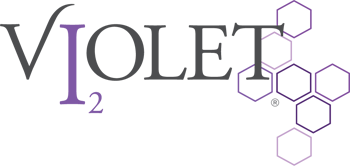Iodine’s Role in the Body (…and the Breast)
If you can channel your memory back to high school chemistry, you may remember learning about iodine. That gorgeous, deep purple solid that when melted forms a deep violet liquid. But iodine serves a bigger purpose than just looking cool. Molecular iodine is essential for healthy bodies, but it’s not something that we can produce on our own. Iodine is essential for the creation of our thyroid hormones, as well as supporting the maintenance of healthy breasts. When we become deficient in iodine, our breast tissue becomes an underlying cause of fibrocystic breast condition, or PMS breasts, and unwanted, uncomfortable breast pain.
Forms of Iodine and Iodine’s Role
There are two primary forms of iodine available for human consumption: iodide (I-) and molecular iodine (I2).
For the chemists reading this, you’ll know that iodine is an unstable element. Meaning that it reacts with its surrounding environment, and actually loses its useful properties when it reacts with oxygen. Because of this, scientists have learned to combine potassium with iodide to form potassium iodide (KI), which the body can use.
Just like wearing different hats and fulfilling different roles as women, it’s important to know that our body utilizes the two types of iodine differently, too. Our thyroid more readily absorbs I- over I2, which can lead to a change in delicate hormone levels within the thyroid. The iodine’s role from I2 is absorbed into the thyroid at a lower rate, and at a higher rate into breast tissue. So what does this mean? Molecular iodine is the preferred form of iodine for breast health, especially when treating fibrocystic breast disease.
How Much Molecular Iodine Do I Need?
In a world where more is more, it’s astonishing to note that as a whole, iodine consumption in the United States alone has dropped by 50% over the last 40 years. It’s likely due to the fact that over the last several decades, the amount of iodine found in our food sources has dramatically decreased. The US recommended dietary allowance (RDA) for iodine is 150-290 mcg for adults, while the Food and Nutrition Board of the Institute of Medicine has set the tolerable upper limit at 1,100 mcg. The downside is these guidelines may be inadequate when addressing certain health conditions, because 60-80% of a person’s iodine intake is absorbed by non-thyroidal tissues, such as our breast tissue.
Because of this, daily iodine doses of 3,000-6,000 mcg have been studied and used safely in those suffering from breast pain and fibrocystic breast condition, leading to a reduction of symptoms altogether.
How Does Molecular Iodine Work?
We know it’s scientific, but the premise is basic: for women with fibrocystic breast condition, the relationship between cell growth and cell death is out of balance. This leads to excessive breast tissue, and ultimately results in breast discomfort. When a daily regimen of molecular iodine is introduced into the system, results have shown to normalize the imbalance and consequently help alleviate the associated symptoms of breast tenderness, swelling, heaviness and aches, and promotes breast health.
Learn more about Violet Daily iodine supplement.
